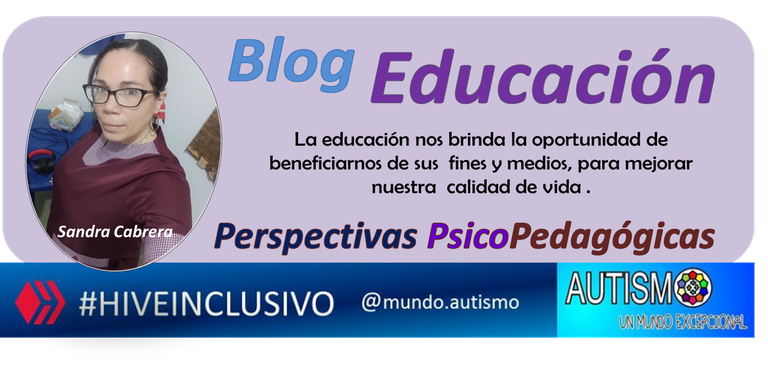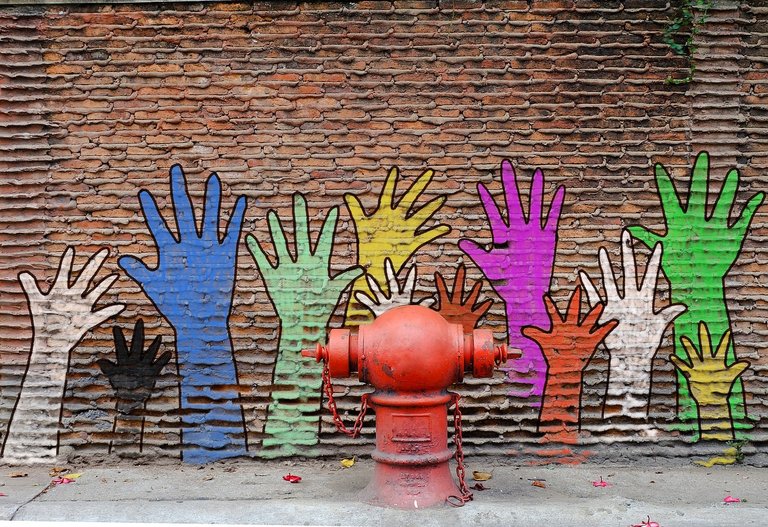 Feliz día, comunidad de Hive. Gracias a todos por la visita a este espacio donde semanalmente compartimos experiencias y oportunidades de aprendizaje de la mano de @mundo.autismo.
Feliz día, comunidad de Hive. Gracias a todos por la visita a este espacio donde semanalmente compartimos experiencias y oportunidades de aprendizaje de la mano de @mundo.autismo.
El desarrollo de los niños autistas está marcado por una variabilidad que caracteriza el espectro, por lo que es necesario invertir tiempo para poder conocer sus debilidades y fortalezas. Llegar a un entendimiento tan profundo como sea necesario sobre la dinámica de su self, por consiguiente, la inversión de nuestro tiempo como psicopedagogos para conectar intersubjetivamente con el niño es de importancia crítica para el éxito del trabajo.
La palabra espectro hace referencia al amplio abanico de síntomas, habilidades y niveles de deterioro o discapacidad que pueden tener las personas con TEA; pese a tener el mismo diagnóstico, las características y gravedad de los síntomas que presentan pueden variar mucho de una persona a la otra.
¿Qué es el TEA?
Todos los niños son diferentes y desde esta diferencia es que esperan ser reconocidos como únicos e irrepetibles. El respeto por el ser humano parte de este principio universal. En este sentido, la complejidad natural del ser requiere una dedicación explícita, cuando se trata de acceder a su interior, gustos, preferencias, miedos y temores. En un niño autista es un viaje de exploración donde el mismo camino no conduce al mismo lugar.
El trastorno del espectro del autismo (TEA) es una condición del neurodesarrollo que afecta a la configuración del sistema nervioso y al funcionamiento cerebral. Se caracteriza por dar lugar a dificultades para la comunicación e interacción social y para la flexibilidad del pensamiento y de la conducta de la persona que lo presenta.
¿Qué es el autismo?
 ▶Happy day, Hive community. Thank you all for visiting this space where we weekly share experiences and learning opportunities with @mundo.autismo.
▶Happy day, Hive community. Thank you all for visiting this space where we weekly share experiences and learning opportunities with @mundo.autismo.
The development of autistic children is marked by the variability that characterizes the spectrum, so it is necessary to invest time in understanding their weaknesses and strengths. Reaching as deep an understanding as necessary of the dynamics of their self, therefore, investing our time as educational psychologists in connecting intersubjectively with the child is critically important for the success of our work.
The word spectrum refers to the wide range of symptoms, abilities, and levels of impairment or disability that people with ASD can have; despite having the same diagnosis, the characteristics and severity of the symptoms they present can vary greatly from one person to another.
What is ASD?
All children are different, and it is from this difference that they expect to be recognized as unique and unrepeatable. Respect for human beings stems from this universal principle. In this sense, the natural complexity of being requires explicit dedication when it comes to accessing their inner selves, tastes, preferences, fears, and anxieties. For an autistic child, this is a journey of exploration where the same path does not lead to the same place.
Autism spectrum disorder (ASD) is a neurodevelopmental condition that affects the configuration of the nervous system and brain function. It is characterized by difficulties with communication and social interaction, and with the flexibility of thought and behavior in the person who suffers from it.
What is autism?

Para poder estimular y despertar el interés por el aprendizaje, debemos encontrar el camino que nos conducen a los centros de interés del niño. Eso no es algo que se logre en semanas o meses; tal vez nos tome más tiempo. Invertir en ello es determinante para tener acceso a las motivaciones que conducen a una disposición para que se produzcan nuevas y mejore formas de interacción.
“los niños autistas pueden aprender, pero parece que sólo lo hacen en condiciones de aprendizaje muy cuidadas. No aprenden apenas a menos que se sigan, de forma muy escrupulosa, reglas específicas de enseñanza, identificadas a través de la investigación en el área del aprendizaje”.
Es decir, el control adecuado del medio para producir aprendizaje es actualmente el recurso esencial, y bastan pequeñas desviaciones en la conducta del docente para que se produzcan graves perturbaciones en el aprendizaje del niño autista.
Orientaciones pedagógicas para la inclusión de niños con autismo en el aula regular
Para garantizar y cuidar estas condiciones del aprendizaje, evitar desviaciones en la conducta, lograr que se produzca un aprendizaje real y significativo, es necesario conocer al niño. Sin ese elemento, poco lograremos lo que nos señalan estas fuentes y autores dedicados al estudio del niño autista en condiciones de aprendizaje.
▶In order to stimulate and awaken interest in learning, we must find the path that leads us to the child's centers of interest. This isn't something that can be achieved in weeks or months; it may take longer. Investing in it is crucial to access the motivations that lead to a willingness to produce new and improved forms of interaction.
“Autistic children can learn, but they only seem to do so under very careful learning conditions. They barely learn unless specific teaching rules, identified through research in the area of learning, are scrupulously followed.”
In other words, adequate control of the learning environment is currently the essential resource, and small deviations in the teacher's behavior are enough to cause serious disruptions in the learning of an autistic child.
Pedagogical guidelines for the inclusion of children with autism in the regular classroom
To guarantee and maintain these learning conditions, to avoid behavioral deviations and to ensure real and meaningful learning, it is necessary to know the child. Without this element, we will achieve little of what these sources and authors dedicated to the study of autistic children in learning conditions tell us.

Es por eso que las familias, pero sobre todo los padres, no deben desestimar estas investigaciones y las recomendaciones que damos en esa primera entrevista, que considero elemental, antes de iniciar un proceso de terapia. Es necesario conceder un tiempo para observar cómo se van moviendo estos elementos interpersonales entre el niño y el psicopedagogo.
Cuando inicia el proceso de atención psicopedagógica, al principio todo parece un tanto lento; inclusive para nosotros. Sin embargo, si no respetamos este período, un espacio valiosamente invertido, comprometemos el pronóstico de la atención. Por lo tanto, es muy importante explicar a los padres estos grandes detalles, que como se explicó, pude tomar meses.
▶That's why families, but especially parents, should not disregard these investigations and the recommendations we give in that initial interview, which I consider essential before beginning a therapy process. It's necessary to allow time to observe how these interpersonal elements move between the child and the psychopedagogical therapist.
When the psychopedagogical care process begins, everything seems a bit slow at first—even for us. However, if we don't respect this period, a valuable investment, we compromise the outcome of the care. Therefore, it's very important to explain these important details to parents, which, as explained, can take months.

No debe confundirse. Durante este tiempo se avanza en el propósito de la atención psicopedagógica a través de un diálogo caracterizado por el compás cuidadoso de dar/recibir/avanzar/detenerse. La construcción de la confianza no se algo que se logre en pocos meses y con el niño autista hay que trabajarla en una forma tan intencional e intencionada, como la construcción del proceso de comunicación, sabemos, especialmente comprometido en el espectro autista.
▶This should not be confused. During this time, progress is made toward the goal of psychopedagogical care through a dialogue characterized by the careful rhythm of give/receive/advance/stop. Building trust is not something achieved in a few months, and with autistic children, it must be worked on in a manner as intentional and purposeful as building the communication process, which we must emphasize, especially in those on the autism spectrum.

El mensaje hoy es que debemos dar la oportunidad de que niño y el psicopedagogo tejan estas relaciones de confianza, sin las cuales el proceso de aprendizaje no se logra. No es aconsejable cambiar constantemente al niño de un servicio a otro. Permitan ese margen para que se estabilicen las relaciones. Teniendo como premisa que todos los niños no tienen el mismo nivel de acceso, tal vez en 2 o 3 meses se puedan cristalizar cambios importantes y positivos que comiencen a dar esos frutos tan esperados
▶My message today is that we must give the child and the educational psychologist the opportunity to build these relationships of trust, without which the learning process cannot be achieved. It is not advisable to constantly move the child from one service to another. Allow that margin for the relationship to stabilize. Assuming that not all children have the same level of access, perhaps in two or three months, important and positive changes can materialize that will begin to bear those long-awaited fruits.
▶I hope you found this information interesting and, above all, useful. If you like, help us by sharing. Greetings and until the next opportunity, in this column on Psychopedagogical Perspectives..
Espero que esta información te haya parecido interesante y sobre todo útil. Si gustas, ayúdanos a compartir. Saludos y hasta una próxima oportunidad, en esta columna sobre Perspectivas Psicopedagógicas..



Soy Sandra Cabrera, licenciada en Dificultades para el Aprendizaje, con estudios de postgrado en Educación Especial Integral, Planificación Educativa y Literatura Infantil. Si te interesan los temas sobre educación especial, la discapacidad y las condiciones especiales del desarrollo, puedes contactarme a través de los números 04128032993 y 0412 8333334 y en:
El canal de Telegram, Trastornos del Aprendizaje.
En las redes sociales Instagram y Facebook1 y Facebook2. Sandra Cabrera Psicopedagoga.
En la cuenta de spreaker, @sandracabrerapodcast.
▶I am Sandra Cabrera, a graduate in Learning Disabilities, with postgraduate studies in Comprehensive Special Education, Educational Planning, and Children's Literature. If you are interested in topics related to special education, disabilities, and special developmental conditions, you can contact me at 04128032993 and 0412 8333334, and at:
The Telegram Learning Disabilities channel.
On social media: Instagram and Facebook1 and Facebook2. Sandra Cabrera, Psychopedagogue.
On the spreaker account, @sandracabrerapodcast.

Acompáñanos, suscribiéndote a Mundo Autismo/Join us by subscribing to Mundo Autismo

Y sé parte de un mundo excepcional, donde tendrás la oportunidad de informarte e interactuar./And be part of an exceptional world, where you will have the opportunity to learn and interact.
Nos encuentras en:/You can find us at:
X


Apoya a @aliento como Testigo./Support @aliento as a Witness

Fuentes de las imágenes:
Logo propiedad de la comunidad @mundo.autismo
Logo propiedad de la Comunidad @aliento
Logo X, editado en PowerPoint, Pixabay
Logo Facebook editado en PowerPoint, Pixabay.
Image sources:
Logo owned by the @mundo.autismo community
Logo owned by the @aliento Community
X logo, edited in PowerPoint, Pixabay
Facebook logo edited in PowerPoint, Pixabay



Cualquiera de nosotros necesitamos un tiempo de adaptación, solo tenemos que pensar en cómo nos sentimos cuando vamos a la consulta del médico y no encontramos al que nos suele atender. Tanto más precisan estos niños que presentan dificultades en sus relaciones con los demás. El vínculo terapéutico requiere de ese tiempo que explicas, tanto más cuanto mayor sea la afectación del niño con autismo. Por otro lado, es entendible la angustia de los padres por obtener diagnósticos rápidos porque piensan que así el tratamiento comenzará antes. Ignoran que el terapeuta lo hace desde la primera mirada al pequeño. Gracias por compartir tan valiosa información en nuestra cadena, haces un bonito y admirable trabajo.
I have picked this post on behalf of the @OurPick project! Check out our Reading Suggestions posts!
Please consider voting for our Liotes HIVE Witness. Thank you!
Gracias por tu comentario y por tu visita.
Lo aprecio.
SaludosHola, @palomap3, tu comentario es interesante porque si aprendemos a comparar cómo nos sentimos en una consulta medica o frente a una examen o situaciones donde sentimos que se nos pone a prueba... ciertamente nos sentimos intimidados y esto es lo que deben sentir los niños en las consultas psicopedagógicas...
La empatía es vuestra herramienta principal, con eso ya tenéis una ventaja grande. Suelo decir que se nace terapeuta, se necesitan unas cualidades que no todo el mundo posee y que no se pueden adquirir por mucho que se estudie. Tus publicaciones me transmiten que cuentas con ella de sobras. 😘
💬 Si te gusta nuestra labor, considera votar este comentario. 💬
Oh, ¡qué bueno ver que se reactivó el comentador! ❤️🤗
Gracias!
💬 Si te gusta nuestra labor, considera votar este comentario. 💬
Muchas gracias @sandracabrera. Entender el tipo de condición de cada niño con autismo es entender sus respuestas y por ende se abre la puerta para saber como abordarlo, como tratarlo, como ganárselo, como lograr ser un apoyo. Te envío mi abrazo 💙 @tipu curate 8
Upvoted 👌 (Mana: 0/75) Liquid rewards.
Gracias, tus palabras y por el apoyo
Saludos, @parauri
💬 Si te gusta nuestra labor, considera votar este comentario. 💬
¡Bienvenidas las Delegaciones / Welcome Delegations
Trail de Curación / Curation Trail
Siempre presente, @mundo.autismo
Congratulations @sandracabrera! You have completed the following achievement on the Hive blockchain And have been rewarded with New badge(s)
Your next target is to reach 78000 upvotes.
You can view your badges on your board and compare yourself to others in the Ranking
If you no longer want to receive notifications, reply to this comment with the word
STOPCheck out our last posts: